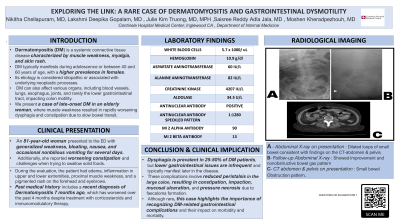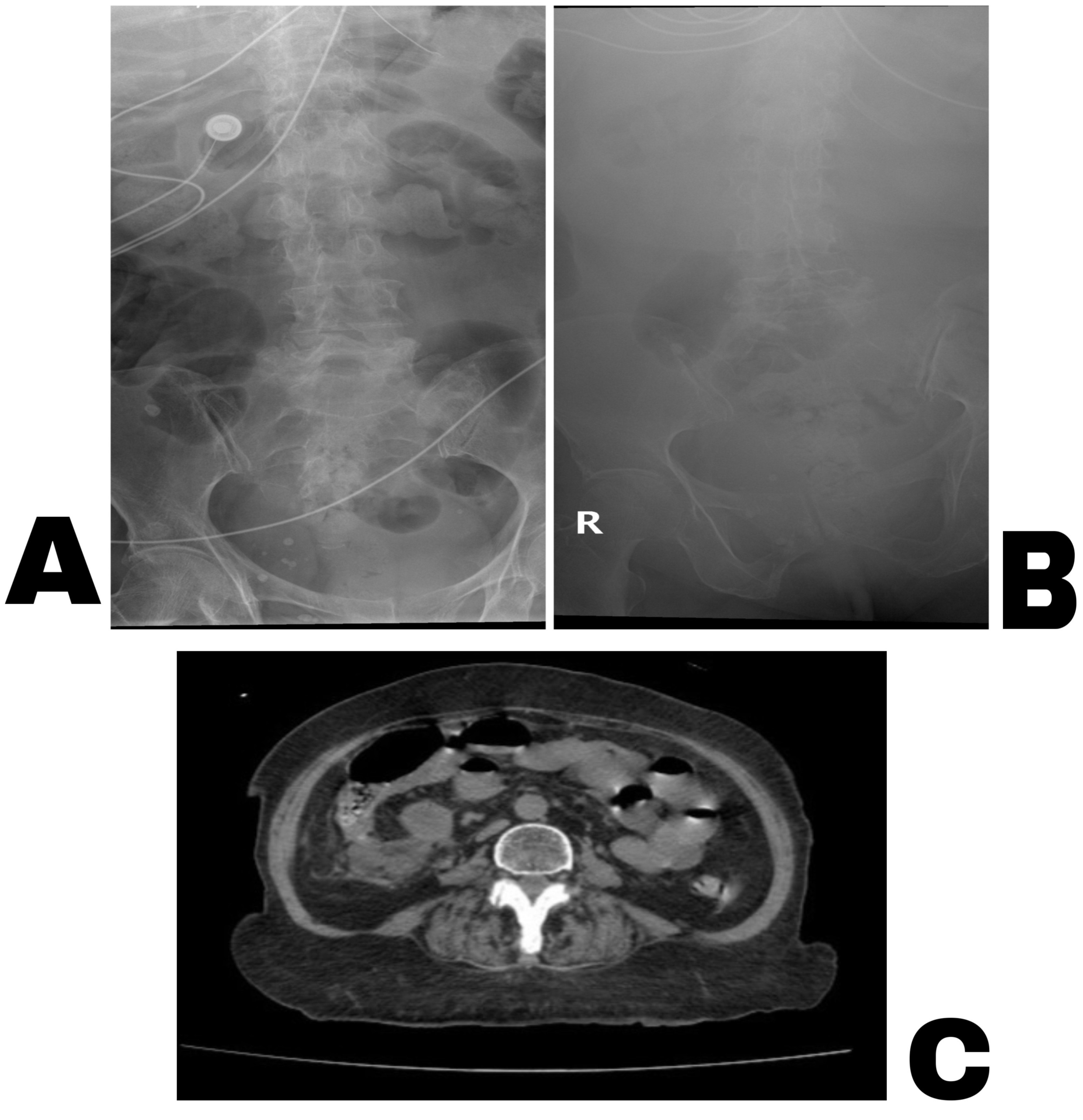Monday Poster Session
Category: Small Intestine
P2677 - Exploring the Link: A Rare Case of Dermatomyositis and Gastrointestinal Dysmotility
Monday, October 23, 2023
10:30 AM - 4:15 PM PT
Location: Exhibit Hall

Has Audio

Nikitha Chellapuram, MD
Centinela Hospital Medical Center
Los Angeles, CA
Presenting Author(s)
Nikitha Chellapuram, MD1, Lakshmi Deepika Gopalam, MD2, Julie Kim Truong, MD, MPH2, Saisree Reddy Adla Jala, MD2, Moshen Kheradpezhouh, MD2
1Centinela Hospital Medical Center, Los Angeles, CA; 2Centinela Hospital Medical Center, Inglewood, CA
Introduction: Dermatomyositis (DM) is a systemic connective tissue disease characterized by muscle weakness, myalgia, and skin rash. DM typically manifests during adolescence or between 40 and 60 years of age, with a higher prevalence in females. Its etiology is considered idiopathic or associated with underlying neoplastic processes. DM can also affect various organs, including blood vessels, lungs, esophagus, joints, and rarely the lower gastrointestinal tract, impacting colon motility. We present a case of late-onset DM in an elderly woman, where muscle weakness resulted in rapidly worsening dysphagia and constipation due to slow bowel transit.
Case Description/Methods: An 81-year-old woman presented to the ED with generalised weakness, bloating, nausea, and occasional nonbilious vomiting for several days. Additionally, she reported worsening constipation and challenges when trying to swallow solid foods. During the evaluation, the patient had edema, inflammation in upper and lower extremities, proximal muscle weakness, and a pigmented rash on the forehead and eyebrows. Past medical history includes a recent diagnosis of Dermatomyositis 7 months ago, which has worsened over the past 4 months despite treatment with corticosteroids and immunomodulatory therapy. CT abdomen pelvis without contrast showed evidence of small bowel obstruction. Initially nonsurgical management was attempted along with corticosteroid therapy, broad-spectrum antibiotics for right lower lobe aspiration pneumonia. A swallow function test showed oropharyngeal dysphagia with pooling in the vallecula and pyriform sinus. Tube feeding was initiated due to the patient's inability to tolerate a solid diet. Due to difficulty swallowing her own secretions, she had a low threshold for intubation. A few days later, she experienced a change in mentation and required intubation for airway protection. Unfortunately, her condition deteriorated, and she ultimately succumbed to death.
Discussion: Dysphagia is prevalent in 25-50% of DM patients, but lower gastrointestinal issues are infrequent and typically manifest later in the disease. These complications involve reduced peristalsis in the large colon, resulting in constipation, impaction, mucosal ulceration, and pressure necrosis due to faecaloma formation. Although rare, this case underscores the importance of recognizing DM-related gastrointestinal complications and their impact on morbidity and mortality.

Disclosures:
Nikitha Chellapuram, MD1, Lakshmi Deepika Gopalam, MD2, Julie Kim Truong, MD, MPH2, Saisree Reddy Adla Jala, MD2, Moshen Kheradpezhouh, MD2. P2677 - Exploring the Link: A Rare Case of Dermatomyositis and Gastrointestinal Dysmotility, ACG 2023 Annual Scientific Meeting Abstracts. Vancouver, BC, Canada: American College of Gastroenterology.
1Centinela Hospital Medical Center, Los Angeles, CA; 2Centinela Hospital Medical Center, Inglewood, CA
Introduction: Dermatomyositis (DM) is a systemic connective tissue disease characterized by muscle weakness, myalgia, and skin rash. DM typically manifests during adolescence or between 40 and 60 years of age, with a higher prevalence in females. Its etiology is considered idiopathic or associated with underlying neoplastic processes. DM can also affect various organs, including blood vessels, lungs, esophagus, joints, and rarely the lower gastrointestinal tract, impacting colon motility. We present a case of late-onset DM in an elderly woman, where muscle weakness resulted in rapidly worsening dysphagia and constipation due to slow bowel transit.
Case Description/Methods: An 81-year-old woman presented to the ED with generalised weakness, bloating, nausea, and occasional nonbilious vomiting for several days. Additionally, she reported worsening constipation and challenges when trying to swallow solid foods. During the evaluation, the patient had edema, inflammation in upper and lower extremities, proximal muscle weakness, and a pigmented rash on the forehead and eyebrows. Past medical history includes a recent diagnosis of Dermatomyositis 7 months ago, which has worsened over the past 4 months despite treatment with corticosteroids and immunomodulatory therapy. CT abdomen pelvis without contrast showed evidence of small bowel obstruction. Initially nonsurgical management was attempted along with corticosteroid therapy, broad-spectrum antibiotics for right lower lobe aspiration pneumonia. A swallow function test showed oropharyngeal dysphagia with pooling in the vallecula and pyriform sinus. Tube feeding was initiated due to the patient's inability to tolerate a solid diet. Due to difficulty swallowing her own secretions, she had a low threshold for intubation. A few days later, she experienced a change in mentation and required intubation for airway protection. Unfortunately, her condition deteriorated, and she ultimately succumbed to death.
Discussion: Dysphagia is prevalent in 25-50% of DM patients, but lower gastrointestinal issues are infrequent and typically manifest later in the disease. These complications involve reduced peristalsis in the large colon, resulting in constipation, impaction, mucosal ulceration, and pressure necrosis due to faecaloma formation. Although rare, this case underscores the importance of recognizing DM-related gastrointestinal complications and their impact on morbidity and mortality.

Figure: A - Abdominal X-ray on presentation : Dilated loops of small bowel consistent with findings on the CT-abdomen&pelvis.
B- Follow-up Abdominal X-ray : Showed Improvement and nonobstructive bowel gas pattern
C- CT abdomen&pelvis on presentation : Small bowel Obstruction pattern.
B- Follow-up Abdominal X-ray : Showed Improvement and nonobstructive bowel gas pattern
C- CT abdomen&pelvis on presentation : Small bowel Obstruction pattern.
Disclosures:
Nikitha Chellapuram indicated no relevant financial relationships.
Lakshmi Deepika Gopalam indicated no relevant financial relationships.
Julie Kim Truong indicated no relevant financial relationships.
Saisree Reddy Adla Jala indicated no relevant financial relationships.
Moshen Kheradpezhouh indicated no relevant financial relationships.
Nikitha Chellapuram, MD1, Lakshmi Deepika Gopalam, MD2, Julie Kim Truong, MD, MPH2, Saisree Reddy Adla Jala, MD2, Moshen Kheradpezhouh, MD2. P2677 - Exploring the Link: A Rare Case of Dermatomyositis and Gastrointestinal Dysmotility, ACG 2023 Annual Scientific Meeting Abstracts. Vancouver, BC, Canada: American College of Gastroenterology.
